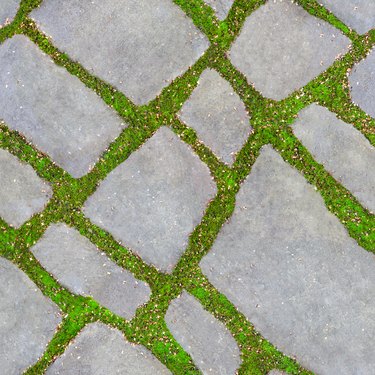
Ground cover planted in the empty spaces between the stones enhances the natural beauty of a flagstone patio or pathway. Not only do the plants help tie the flagstone into the surrounding landscape, but they also make a garden trail or patio feel more inviting. Plants typically used around flagstones are low-growing, hardy, and don't require pruning or mowing. They also keep weeds down, which often means less maintenance than required by gravel, sand, or mulch used between stones.
Plants to Use Between Flagstones
Video of the Day
Low-growing ground cover plants that spread in a bushy manner rather than sending out long runners work best between flagstones. Choose plants that can handle foot traffic, and consider the amount of sunlight the area receives to choose plants that grow well in that amount of sunlight. Plants commonly used between flagstones are Woolly thyme (Thymus pseudolanuginosus), Pink Chintz thyme (Thymus serpyllum 'Pink Chintz'), Roman chamomile (Chamaemelum nobile), Scotch moss (Sagina subulata), and Blue Star creeper (Isotoma fluviatilis).
Video of the Day
Things You'll Need
How to Plant Between Flagstones
Step 1: Remove the Existing Filler
Dig out the soil or gravel filler between the flagstones using a hand trowel. Remove the top 1 to 2 inches of soil.
Step 2: Prepare the Plants
Remove the plants from their pots or plastic planting cells. Turn the pot or cell upside down and gently shake the plant out. Unlike other types of plants, it's alright if some of the roots of ground cover plants are damaged while removing them from the pot.
Step 3: Spread the Plant Roots
Spread the roots by gently grasping them with one hand on each side and slowly pulling them apart. It's OK if a few roots break away at the bottom, but take care to keep the roots near the plant intact.
Step 4: Make Holes for Plants
Dig small holes, about 2 inches deep, between the flagstones for the individual plants. Spacing varies among plants, but for the most popular, such as Woolly thyme, Pink Chintz thyme, and Blue Star creeper, 6 inches between plants is standard. Slower spreading plants like Scotch moss and Roman chamomile may be planted closer, about 4 inches apart. Since ground cover plants are intended to spread and meet up with each other, spacing is not critical, but placing them too close together, within 2 to 3 inches, can cause them to compete with each other for nutrients. Spacing them farther apart, such as 8 to 12 inches, is acceptable, but it'll take longer to cover the empty space between the flagstones.
Step 5: Plant the Ground Cover
Place the plants in the holes, filling in around the plant with the soil dug out of each hole. The bottom of each plant should be even with or just slightly below the top edge of the flagstone. If the ground is uneven, fill in low areas with dirt or lower high areas by removing additional soil. Uneven flagstones should be leveled before planting by lifting them and placing small gravel pieces in low spots.
Step 6: Water the Plants
Water each plant. Insert your finger 2 inches into the soil to make sure the water has penetrated far enough to reach the roots. If the soil is dry at 2 inches deep, water again until the top 2 inches of soil are moist.
Step 7: Add Sand and Topsoil
Mix together equal parts sand and topsoil. Spread the sand and soil mixture between the flagstones, tamping or pressing it down very lightly, just enough to keep it in place. The mixture needs to remain loose enough to allow good drainage and the roots of the new plantings to spread easily.
Step 8: Irrigate the Plants
Water the plants regularly, keeping the soil constantly moist, until the plants are well established.
Tip
Pull larger plants apart and divide them into 2 to 3 inch sections for planting to cover more area while purchasing fewer plants.
Warning
Don't step on the plants in your flagstone patio or walkway until they are well-established and begin to spread. Even hardy plants that can withstand foot traffic may struggle if walked on when newly planted.